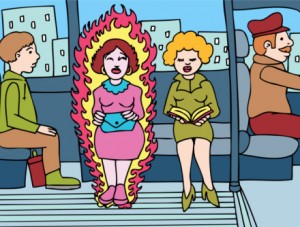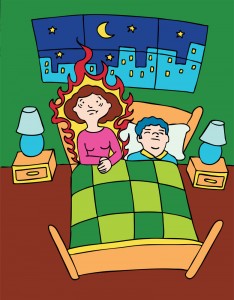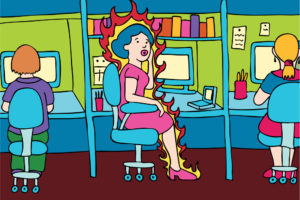Video interview with James Simon, MD George Washington University, Washington, DC
New study finds low dose Paroxetine lowers hot flashes
Perhaps you know someone like Karen. She’s in her early 50s and a breast cancer survivor. For her, hot flashes are a real problem. She knows she can’t take estrogen, and until now, end of story.
 There currently is no FDA approved prescription medicine available to get her hot flashes under control. For women like Karen and for 75% of all women in perimenopause and menopause, hot flashes can be challenging.
There currently is no FDA approved prescription medicine available to get her hot flashes under control. For women like Karen and for 75% of all women in perimenopause and menopause, hot flashes can be challenging.
One study I heard at the recent annual meeting of the North American Menopause Society (NAMS) in Orlando, Florida is hoping to change that by gaining FDA approval for the treatment of hot flashes sometime in 2013. It’s a variant of the antidepressant drug – paroxetine. You many know the parent drug by one of these names: Aropax, Paxil, Pexeva, Seroxat, Sereupin.
The purpose of the study was to find out if a lower dosage of paroxetine could serve as an effective new non-hormonal treatment for hot flashes. The new drug’s slightly different chemical structure, technically called a Low-Dose Mesylate salt of Paroxetine or LDMP, allows it to be used in a lower dosage. The intent was to pre-vent the frequently found side effects of nausea, weight gain and reduced sexual function that are common with the full dosage of paroxetine.
 The study evaluated LDMP in ap-proximately 500 women who had at least 7 hot flashes daily and were very affected by their symptoms. Half of the women received LDMP and the other half received a placebo. The women were followed for 12 weeks for efficacy and for a total of 24 weeks for safety.
The study evaluated LDMP in ap-proximately 500 women who had at least 7 hot flashes daily and were very affected by their symptoms. Half of the women received LDMP and the other half received a placebo. The women were followed for 12 weeks for efficacy and for a total of 24 weeks for safety.
Paroxetine comes in dos-ages of 10mg, 20mg, 30mg and 40mg. In this study, a low-dose of 7.5 mg of the mesylate salt of paroxetine (LDMP) was able to statistically reduce hot flash both in frequency and severity compared to women who received a placebo.
The affect began at one week and became statistically significant shortly after that. The benefits remained statistically significant at 4, 8, 12 and 24 weeks, which was the duration of the study.
There was a low frequency of side effects; most commonly nausea, that occurred in 4% of treatment group compared to 1% of placebo. Hot flashes affect approximately 75% of women as they enter and pass through perimenopause and menopause. As millions of women know, hot flashes are very disruptive and affect the way a woman feels and sleeps and that affects a woman’s quality of life.
 So naturally, women in menopause are looking for a safe and effective treatment for hot flashes, especially if she has breast cancer. For now, the one approved and effective treatment for hot flashes is estrogen. Unfortunately, estrogen, also called estrogen therapy (ET), hormone therapy (HT) or in the past, hormone re-placement therapy (HRT) comes with potential side effects and risks that make it an unacceptable or undesirable choice for many women.
So naturally, women in menopause are looking for a safe and effective treatment for hot flashes, especially if she has breast cancer. For now, the one approved and effective treatment for hot flashes is estrogen. Unfortunately, estrogen, also called estrogen therapy (ET), hormone therapy (HT) or in the past, hormone re-placement therapy (HRT) comes with potential side effects and risks that make it an unacceptable or undesirable choice for many women.
Other treatments include over the counter remedies and lifestyle changes. LDMP is currently being evaluated at the FDA and hope-fully will become an FDA approved nonhormonal alternative to treat hot flashes by the end of 2013.





